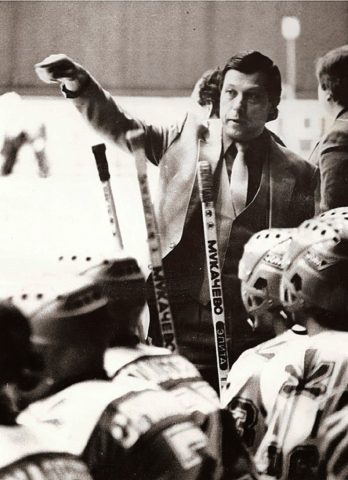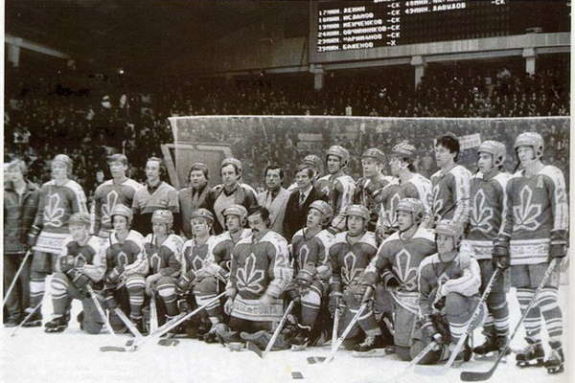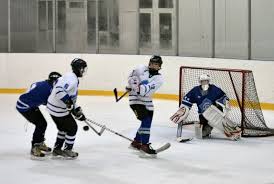
 Vyacheslav Hnatyuk
The Hockey Writers
Vyacheslav Hnatyuk
The Hockey Writers
57
Reads
0
Comments
“Sokil” Kyiv Boasts Great Past, Hopes for Revival Linger
“Sokil” Kyiv has achieved the most of any club in Ukraine’s hockey history. Its major achievement in Soviet hockey is third place in the USSR hockey championship of 1985. Besides that, the club has won Ukraine’s gold medal twelve times since 1993. Moreover, it nurtured major stars for the Ukrainian hockey and international clubs, including the NHL.
The Ukrainian word “sokil” stands for “falcon” in English. Metaphorically, the club was learning to fly in the seventies, soared in the eighties, got used to flying low in the nineties and dropped dead with the turn of the century. In many respects, the club’s fortunes went hand in hand with the development of Ukraine’s economic and social life.
Related: 3 Legendary Olympic Hockey Players You’ve Never Heard Of
Nowadays, only the most hardened fans believe in the resurrection of the Ukrainian hockey legend dubbed “Sokil” Kyiv. Of course, it is only right not to lose hope. To give credit to the hopeful, it is still possible to breathe life into the old brand.
The city of Kyiv still carries the ice hockey school for the kids called “Sokil Hockey School.” That is where the big hockey stars of yesteryear work as coaches until this very day.
Historically speaking, “Sokil” was not the first team to play competitive hockey in Kyiv, Ukraine’s capital. Thus, “Dynamo” Kyiv, a club with a major soccer team, used to have an elite hockey team throughout the 1960s and into the early 1970s.
Still, it was “Sokil,” which managed to compete against the grand clubs in the Soviet hockey’s elite division – Vysshaya Liga. Besides winning the Soviet bronze medal in 1985, the team made it into the top five between 1976 and 1991. The coaching genius of Anatoliy Bogdanov, who played for the team in its early years, crafted this success from a strategic point of view.
At the Junction of Politics and Sports
It goes without saying that political patronage was a major factor for the club’s success. Of course, Soviet Ukraine’s politicians would not go on the rink with the players, but they ensured that the team’s scouts and coaches had enough clout for luring talented and ambitious players from Russia’s remote towns to Kyiv.

The clout back in the 1970s and 1980s for Soviet people mostly meant the possibility to live in separate flats instead of overcrowded factory dormitories. “Lada” and “Volga” cars made young men’s heads swirl and they could get their cars by playing for “Sokil.” Kyiv, a beautiful city on the shores of the Dnipro river, offered a comfortable lifestyle combining the cultural offering of a megalopolis with natural beauties lying at your doorstep.
It is not surprising that Sokil’s hockey players and coaches were known by name in the highest offices of socialist Ukraine. On the one hand, the republic’s leadership had to deliver achievements in sports in order to help the Soviet Communist party show the world advantages of the socialist way of life. On the other hand, however, the natural rivalry between Soviet republics could only be played out in sports. And ice hockey was only one of them.
Talent Search Throughout the USSR
The club started small but full of ambition. While playing in the “Pervaya Liga” the club’s management knew that it needed players, who would not only win the ticket into the elite division. The task was to get a strong footing there for further victories.
Therefore, “Sokil’s” scouts would not shun aggressive tactics for taking top talents from elite clubs, or from clubs, which had a good chance of making it to the elite division.
“Sokil’s” longtime goalie Yuriy Shundrov, for example, arrived in Kyiv from Penza, where he played for “Dizelist.” Shundrov also played for the Soviet’s youth national teams. After joining “Sokil” Shundrov became the team’s bulwark. The field players relied on Shundrov at all times.
Mykola Ladygin, a defenseman, grew as a player in the Urals. Before joining “Sokil” Ladygin had played in Minsk, Lipetsk, and Izhevsk. Thus, he brought lots of playing experience from Russia to the newly born Ukrainian club.

As for forwards, Anatoliy Dyomin grew up in Moscow’s environs and initially played for “Rubin” in Balashykha. Later, Dyomin joined a club in Ukhta, a town in the far north, to gain more game exposure and learn to play 30-second shifts under the open skies at -36 degrees Celcius. From there, Dyomin moved to Kyiv and became the team’s best scorer in his first season. He earned a new flat with his level of game in half a year.
Dyomin, Shundrov, and Ladygin are just examples of how the team was formed. Hardened and experienced, although oftentimes young, ice warriors formed the backbone of the team for the next decade. In 1978 “Sokil” made it to the strongest league of Soviet hockey. By 1981 “Sokil” played assertive hockey, even against “CSKA.”
Getting Ready for the Jump
After the foundations were laid, Bogdanov and Kyiv’s top sports bosses set their eyes on the medals. More exposure to various styles of game and flesh and blood became necessary to achieve the goal. Scouting efforts intensified, local sports schools received sufficient funding, and “Sokil” started touring Europe.
“Sokil’s” scouts knew that they were on the right path if they could attract young talents with experience with either top clubs, or the youth national teams. Thus, a whole line of forwards joined the team in 1980 – Serhiy Zemchenko, Andriy Zemko, and Andriy Ovchynnykov. Before Kyiv, they had played in “Yermak” Angarsk and for the U-20 national team of the USSR. Mykhailo Tatarinov arrived in Kyiv from Angarsk in 1983.
Mykola Narimanov and Ramil Yuldashev also starred in the Soviet U-20 team. Thus, these players brought in not only skill but also an understanding of the best international hockey cultures and work ethics.
Related: Remember Viktor Tikhonov – A Hockey Legend
Narimanov was good at singing, too. He once sang duo on national TV: the song was called “A Singer and a Hockey Player.” It describes two friends exchanging their childhood dreams of becoming a singer instead of a hockey player and vice versa.
Starting in the early eighties “Sokil” gained more international exposure. Playing tournaments and series’ of friendly matches in Slovakia and Finland became a rule. So, games against “Slovan” Bratislava, “Plastika” Nitra and the best Finnish teams became routine preparations for Kyiv’s hockey team during its seasons in the 1980s.
“Sokil’s” Big Season
The season that has been written in capital letters into the team’s history is that of 1984-85. The preparations for the national championships started in August 1984 in Kyiv with a tournament of the teams from the Ukrainian capital’s sister cities – Finnish Tampere and Slovak Bratislava. Although “Ilves” Tampere won the tournament, “Sokil” got international experience. Right before the tournament the team had welcomed two newcomers – Petro Malkov from “Kristal” Saratov and Ramil Yuldashev from “Salavat Yulayev” Ufa.
In September, the team went to the tournament of the “Sovetskiy Sport” daily held in the cities of Tallinn, Leningrad, and Riga. There, the team from Kyiv competed against the Czech club “VSZ” from Kosice, CSKA Moscow, Dinamo Riga and Izhstal from Izhevsk.
The team started into the season with two draws: against “Krylya Sovietov” from Moscow (2:2) and “Khimik” from Voskresensk (1:1). These games set the pattern for the whole season. “Sokil” came out of few games without points at all. During the season they lost only against CSKA, the Soviet super club.
Such teams as “Dinamo” Moscow and “Torpedo” Nizhniy Novgorod were hard nuts to crack for the Kyiv team. But “Sokil” managed to gain enough traction during the season, so that it lost some games to “Dinamo” and “Torpedo”, but played even games with them, too.
After the first half of the season, “Sokil” toured Czechoslovakia and Finland to play Christmas and New Year’s games for the local crowds. The playing experience was priceless for the team.
Although in the second half of the championships, “Sokil” registered five losses, won seven times, and tied three games. Notice, that they finished tied 5:5 against “Dinamo” Moscow on Feb. 19, 1985. This was a sign of readiness to compete against the big Moscow teams.
During the second half of the championships “Sokil” ensured that it would play in the micro tournament of the top three teams: “CSKA”, “Dinamo” and “Sokil.” This secured bronze medals.
In the final part of the championships the team failed to win a single game against “Dinamo” or “CSKA”. Thus, “Sokil” ended the season with 41 points, whereas “Dinamo” had 67 and “CSKA” 68.
Although the difference in the points was self-explanatory in the team’s respective powers, the Ukrainian fans decided to treat the team as heroes and champions of their hearts. This attitude stays within the community of hockey fans in Ukraine until today.
Sokil’s International Imprint
During the Perestroika times “Sokil” played two games against the NHL times. On Sept. 16, 1989, the Calgary Flames arrived in Kyiv as defending Stanley Cup champions bringing in their new star Sergey Makarov. Although the arena in Kyiv was full and “Sokil” played their top game, they lost 2:5 to the Flames.
A year later, on Sept. 19, 1990, the Minnesota North Stars played in Kyiv. “Sokil” stepped up efforts and won 5:0. Anatoliy Nayda, who scored a hat trick that night, explained his success by luck and the efforts of his tremendous partners – Dmytro Khrystych and Ramil Yuldashev. As for his play, Naida said: “Yes, I scored three goals, but this was by far not the best game in (my) career. The most memorable, indeed.”
Dmytro Khrystych, Oleksiy Zhytnyk, and Aleksander Godynyuk are former “Sokil” players, whose careers in the NHL were full-fledged. There has been a number of “Sokil” hockey school graduates who made it to the NHL and achieved a lot there. To name just a few are Ruslan Fedotenko, Alexei Ponikarovsky, and Anton Babchuk.
The Olympics and the IIHF world championships saw many “Sokil” players as participants. Zhytnyk won Olympic gold in 1992 on the roster of the United Team of the former USSR. Valeriy Shyryayev won the World Championships in 1989 together with the Soviet national team. And in 1990 Dmytro Khrystych and Mykhaylo Tatarinov also won the same title for the Soviet Union.
Withering Away
The Soviet Union collapsed in 1991 and total poverty and political misery hit the newly independent Ukraine. As a reaction to realities of life “Sokil” became a total talent export machine. Players, young and old, hit the road in search of better fortunes. Some, usually mature personalities and strong players, achieved success in various leagues – starting with Russia and going as far West as Los Angeles. Others, with more need to start early and less time to prepare for international careers, found jobs in minor leagues, but also managed to become experienced players and coaches.
Related: Russell Bowie – The Pre-NHL Wayne Gretzky
During the 1990s, the team found the city of Kyiv as its sponsor. Then-Kyiv mayor Oleksandr Omelchenko liked the sport and did a lot to keep the school and professional team afloat. After Omelchenko lost city elections “Sokil’s” lucky strike withered away.

Nowadays, the team is owned by businessman Serhiy Taruta, who did little to keep the hockey going in the city. The state of Ukraine is currently financing the reconstruction of sports complex “Avangard” – “Sokil’s” traditional training rink in Kyiv. After the reconstruction is over, “Sokil” hockey school for children and youth will move to “Avangard.”
Serhiy Varlamov, executive director of the Ukrainian Hockey League, said in September 2019: “When it (sport complex “Avangard”) is set into operation, we will be able to get going with giving a re-birth to “Sokil” hockey club.”
The post “Sokil” Kyiv Boasts Great Past, Hopes for Revival Linger appeared first on The Hockey Writers.
Popular Articles

















































 Canucks Vancouver
Canucks Vancouver Sharks San Jose
Sharks San Jose Flames Calgary
Flames Calgary Avalanche Colorado
Avalanche Colorado Coyotes Arizona
Coyotes Arizona Golden Knights Vegas
Golden Knights Vegas Wild Minnesota
Wild Minnesota Red Wings Detroit
Red Wings Detroit Blues St. Louis
Blues St. Louis Blackhawks Chicago
Blackhawks Chicago Blue Jackets Columbus
Blue Jackets Columbus Hurricanes Carolina
Hurricanes Carolina Jets Winnipeg
Jets Winnipeg Predators Nashville
Predators Nashville Ducks Anaheim
Ducks Anaheim Oilers Edmonton
Oilers Edmonton Sabres Buffalo
Sabres Buffalo Rangers New York
Rangers New York Bruins Boston
Bruins Boston Panthers Florida
Panthers Florida Senators Ottawa
Senators Ottawa Lightning Tampa Bay
Lightning Tampa Bay Capitals Washington
Capitals Washington Islanders New York
Islanders New York Devils New Jersey
Devils New Jersey Maple Leafs Toronto
Maple Leafs Toronto Flyers Philadelphia
Flyers Philadelphia Penguins Pittsburgh
Penguins Pittsburgh Stars Dallas
Stars Dallas Kraken Seattle
Kraken Seattle Kings Los Angeles
Kings Los Angeles


